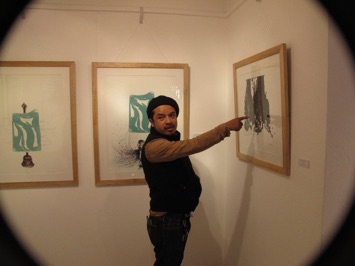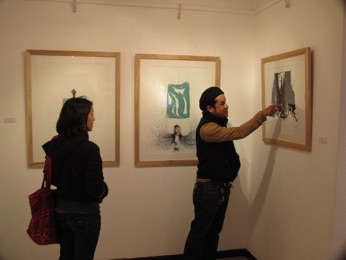






© KCAC 2012 All rights reserved UK registered charity 1121118

CONVERSATIONS WITH THE ARTIST Sangeeta Thapa
I first came across Kabiraj's work while he was a BFA student at Kathmandu University. Then in 2009 the Siddhartha Art Gallery organized his graduation show at the Annapurna Hotel. As a resident of Boudha and living close to the sacred Boudhanath Stupa, he was inspired by the strong cultural and spiritual environment. His work became "a search for inner enlightenment for the tranquility of the inner self". His exhibition “Transcendental Vibrations”, focused on portraits of Buddhist monks. His command of oil paint, oil pastel and ink and his sensitivity to line were evident in compelling portrait studies of this period. After graduation, Kabiraj journeyed to Japan with the dream to study art in a country with a long and illustrious history in printmaking. Accepted at the prestigious Meisei University Center of Art and Design in Tokyo, but without resources to pay for his education Kabiraj had to take on multiple jobs to cover both educational expenses and the cost of living in one of the most expensive cities in the world.
Talking to the artist about his time in Japan, I learnt of the many challenges. He spoke no Japanese and it took more than two years to learn the language and begin to understand traditional Japanese culture with all its nuances. He had issues of self esteem and identity in a country where foreigners are regarded as gaikokujin or outsiders. The loneliness and frustration was debilitating and he began to doubt his artistic journey "Learning and practicing art gradually became secondary to the urgency of earning a living. I felt a deep necessity to regain my identity and compelled myself to find a balance between the two, finding time and space for art within my hectic earning schedule.”
In Kabiraj's body of work in this exhibition From Tokyo to Kathmandu – Recollections in Print, the loneliness of the artist on his spiritual quest and the quest to master new techniques are not parallel journeys but the continuation of a more profound journey. The journey of the karmic self with obstacles central to the journey such as finding the right place of instruction and finding a teacher. While in Japan, Kabiraj studied a range of printmaking techniques before deciding on lithography as his medium. He was fortunate to find a mentor in the celebrated printmaker Shibuya Kazuyoshi. In an interview with Kabiraj he said "Drawing on stone excited me and increased my interest in lithography. The features of the technique matched my creative tendencies, allowing my emotions to transmit easily into chemicals, ink, the surface of the stone surface and later onto paper."
As Kabiraj experimented with the process of lithography, a series of abstract works evolved. He found the task of grinding the stone meditative which gave him time to contemplate each tremulous movement of the placing of lines and color on stone; "..each stroke and the rawness of their movement were expressions of my raw temperament which was composed of both fear and aggression. I pursued the idea of transforming my emotions into prints and rediscovered my thoughts through the imprints and textures in litho".
The hallmark of these abstract works is found in the fluid lines interspersed with playful squiggles and a sense of abandonment in the dripping of colour. Through this series of abstract works he began to slowly reaffirm his identity as an artist. cite example
Experiments with portraiture and figurative work followed in litho, monotype and woodcut. Kabiraj was able to prove that he could render his portraits and figurative works in print with finesse and sensitivity. cite example:
A series of new prints which hark back to his earlier spiritual bent are also from this period, replete with temple bells and divine forms : cite example
During his four years in Japan, Kabiraj participated in several print exhibitions and his diligence and dedication to printmaking earned him a job as a teaching assistant at Meisei University's Printmaking Department. There he taught lithography, woodcut, drawing and painting for a year. In March 2011, a terrible tsunami hit Japan. The devastation caused and its aftermath play havoc with Kabiraj's mind. Battling depression while coming to terms with the searing devastation, he turned to printmaking to heal himself; "engrossed in its process, I could escape from the shadows of insecurity and depression caused by the tsunami and its aftermath. It was a harsh life and I was struggling".
During the last phase of his time in Japan, Kabiraj experimented with an action painting series in monotype. He developed both confidence and skill to paint directly onto litho plates in swift and bold strokes. In my conversation with the artist I learnt that it was the combination of ink viscosity, chemicals and the intricacy in timing that "triggered" his creative instincts. The necessity of taking risks in printmaking, while not knowing what the outcome could reveal, helped him overcome his insecurities. He told me that while taking these steps he was subconsciously hauling himself from his darker experiences; " I liked the idea of preparing the plates without any plans, not knowing the end result. The scale, speed and colors of these printed strokes spoke the language of my inner motions." cite examples
Kabiraj returned to Kathmandu earlier this year and found his four years in Japan, both as a student and teacher, had left an indelible impression on him.
Awarded a residency at the Kathmandu Contemporary Arts Centre, but with limited local printmaking resources available, Kabiraj decided to make woodcuts, a skill he had mastered at Meisei University. A week into the residency, our main studio had been transformed into a Japanese printmaking studio with huge wooden boards, bottles of ink, cutters and rolls of lokta paper. During his four-month residency, he looked back at the Tsunami through his recollections in print. The trauma of the tsunami was still there. "In my subconscious I constantly questioned my sense of stability.“ The motifs engraved on the wood narrate the havoc and wreckage created by the Tsunami, destroying cities in seconds and wrecking uncountable lives on land and sea. His work also touches on the tragedy of Fukushima. Witnessing these catastrophes, with the fragility and uncertainty of existence exposed, was shattering to him. Each image printed here resonates with the tragedy, its after-effect and the collective spirit of the Japanese to reconstruct life anew". Cite example
On the third floor of the Gallery the artist has created a meditative chamber, hanging the four woodcut panels he used to make the tsunami series. The panels are covered in black ink and the chamber is dimly lit, allowing the viewer a closer look at Kabiraj's intricate engravings. Inside the chamber the sound of the artist engraving on wood is heard – in homage to both the deceased and to the art of printmaking.
In his poem Ulysses the poet Alfred Lord Tennyson wrote " I am a part of all that I have met...”
This exhibition reaffirms Tennyson’s words and documents the courageous journey of an artist with an indomitable spirit.











________________________________________________________________________________________________________________________________
Kabi Raj Lama
scholarship artist 2014


